Earlier this week, the news agency AFP carried an interesting report detailing the Chinese government’s support to Myanmar’s ethnic armed organizations and rebel groups.
According to the report, Beijing has already handed over nearly 13 million doses to the military junta that overthrew the elected civilian government in February, plunged Myanmar and its healthcare system into chaos. At the same time, it has also more quietly supported the armed rebel groups whose autonomous territories border on China’s Yunnan province, some of which are in open conflict with the military government.
AFP confirmed that the Kachin Independence Army, Shan State Progress Party, and Ta’ang National Liberation Army had all received donations of vaccines and other medical aid from China, including training and construction materials for quarantine centers.
The report also revealed that in the border town of Muse, the main gateway of trade between China and Myanmar, a new quarantine center is under construction that will house up to 1,000 beds for traders keen to resume business. The construction workers are from Myanmar, but the construction materials are from Yunnan.
It has also been previously reported that the United Wa State Army (UWSA), Myanmar’s most powerful ethnic armed group, which enjoys an umbilical (though by no means totally supine) relationship with the Chinese government, has received a range of COVID-19 aid.
In December, The Irrawaddy reported that the Red Cross in Pu’er, a city in southern Yunnan, had provided the UWSA with a $400,000 COVID-19 testing lab at its headquarters in Panghsang. The UWSA previously used rapid test kits provided by the Chinese.
According to the same report, the UWSA and the National Democratic Alliance Army, a subordinate militia based in the town of Mong La on the China-Myanmar border, have both received health assistance from China, including disinfectant, personal protective equipment, and training from Chinese medics on COVID-19 prevention.
As the AFP story noted, these Chinese efforts testify to the public health risks that crisis-hit Myanmar poses to China’s “zero COVID-19” strategy. After the February coup, vaccinations and contact tracing efforts collapsed as the country descended into turmoil and thousands of doctors and health care workers walked off the job in protest against the coup.
The country’s COVID-19 crisis quickly had its echo in Yunnan. In Ruili, which sits across the border from Muse, outbreaks in March and July that started with cases from Myanmar, forced the authorities to introduce two waves of lockdowns and mass testing. On the latter occasion, this drove China’s largest daily toll of infections for six months, prompting Yunnan provincial vice-governor Zong Guoying promised to establish a “fortress of iron” to stop further transmissions from Myanmar.
The Chinese donations also speak to the realities of how power operates in the border region. Given that large parts of its frontier with Myanmar has lied for most of history beyond the effective control of Myanmar’s government, it makes sense that China would offer support, if only to protect itself. The creation of a “buffer zone” was how Enze Han of the University of Hong Kong described it to AFP.
In addition to the “legitimate” trade between the two countries, the remote and poorly-policed border between the two countries has long been a notorious as a conduit for all manner of illicit trades, from luxury hardwood, jade and endangered animal parts to Chinese-made precursor chemicals that fuel the methamphetamine labs of Myanmar’s Shan State. This porous frontier has thus provided the perfect for conduit for COVID-19, even before the current crisis in Myanmar.
It is partly for this reason that the Chinese government began construction barbed-wire fence running along long stretches of the border. The construction of the “border wall” followed COVID-19 outbreaks in September 2020 that sent the city of Ruili into “wartime mode” and pushed the local authorities to launched a campaign to test the city’s entire population of more than 200,000 people. In July, Radio Free Asia reported that a 600-kilometer span of the barrier was nearing completion.
In addition to preventing the spread of COVID-19-positive travelers, the fortification of the border also has the benefit of granting the Chinese authorities greater control over who and what crosses the frontier. This goal will likely persist regardless of who rules in Myanmar, and how competent they are.

































